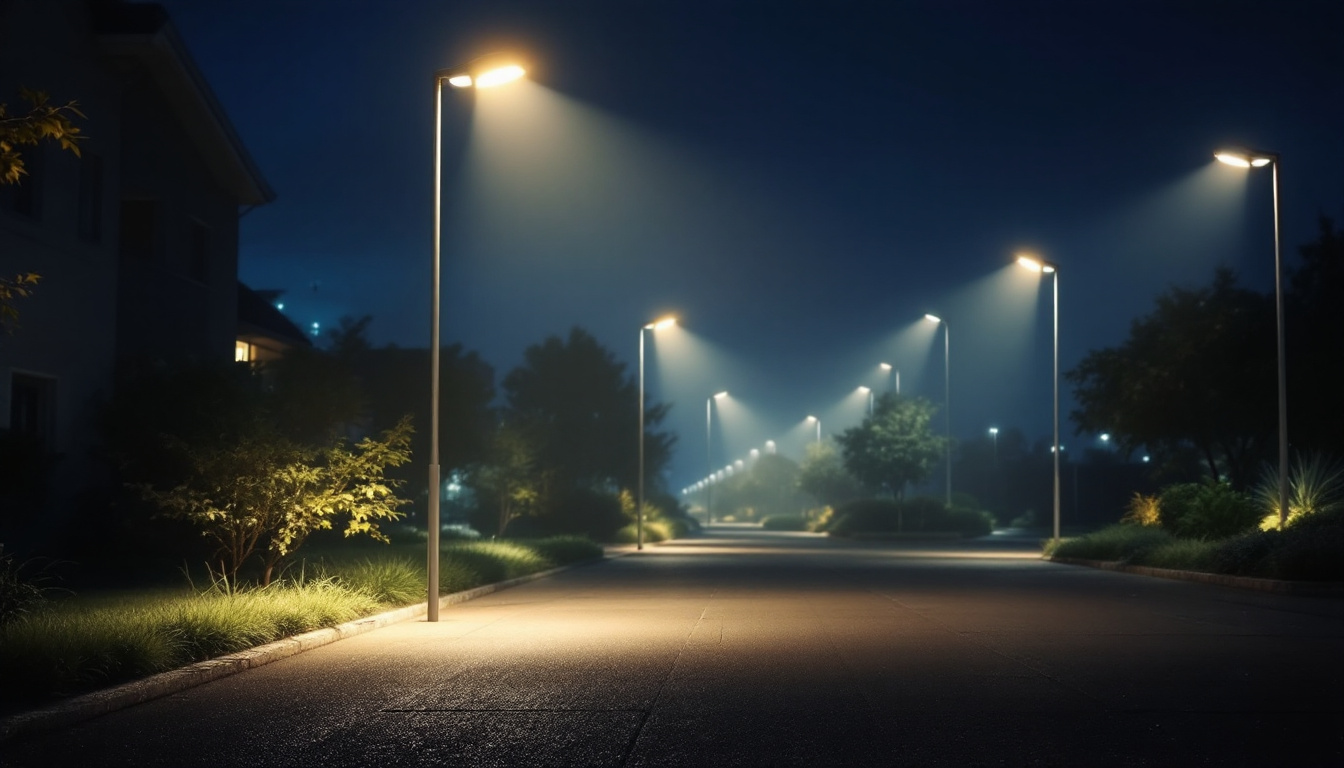
In the competitive landscape of lighting installations, outdoor flood lights have emerged as a lucrative segment for contractors. These versatile fixtures not only enhance the aesthetic appeal of properties but also provide essential safety and security features. Understanding how to maximize profitability in this niche can significantly impact a contractor’s bottom line.
The demand for outdoor flood lighting has surged in recent years, driven by various factors including heightened security concerns, increased outdoor activities, and the growing trend of residential landscaping. As homeowners and businesses alike seek to improve their outdoor environments, the need for effective lighting solutions becomes paramount. This increased demand is not only about aesthetics; it also plays a critical role in enhancing safety and functionality in outdoor spaces. For instance, well-lit pathways and entrances can deter potential intruders, while also providing a welcoming atmosphere for guests and customers.
Several trends are shaping the outdoor lighting market. Smart technology integration, for instance, has revolutionized how flood lights are controlled and operated. Homeowners are increasingly looking for systems that can be managed via mobile devices, allowing for greater flexibility and convenience. Additionally, energy efficiency is a significant concern, with many clients opting for LED solutions that not only reduce energy costs but also offer longer lifespans. The rise of solar-powered flood lights is another noteworthy trend, as these environmentally friendly options allow users to harness renewable energy, further appealing to eco-conscious consumers. Moreover, the aesthetic aspect of outdoor lighting is gaining traction, with innovative designs that blend functionality with artistic expression, allowing homeowners to create unique outdoor ambiances.
Identifying the right customer base is crucial for maximizing profitability. Residential clients, commercial businesses, and municipal projects each present unique opportunities. Contractors should tailor their marketing strategies to appeal to these different segments, highlighting the specific benefits of flood lighting relevant to each audience. For instance, residential clients may prioritize safety and ambiance, while commercial businesses might focus on visibility and energy savings to enhance customer experience. Municipal projects, on the other hand, often require compliance with regulations and standards, making it essential to emphasize reliability and durability in lighting solutions. Understanding these distinct needs allows contractors to craft targeted messages that resonate with each group, ultimately driving sales and fostering long-term relationships.
Selecting the appropriate flood lights can make a substantial difference in both installation success and customer satisfaction. Quality products not only enhance the overall aesthetic but also ensure longevity and reliability, which are critical for repeat business and referrals. The right choice can transform outdoor spaces, providing security and ambiance that clients will appreciate for years to come.
There are various types of flood lights available, each designed for specific applications. LED flood lights are popular due to their energy efficiency and long lifespan. Halogen flood lights, while less efficient, provide a warm light that some clients prefer for aesthetic reasons. Understanding the advantages and disadvantages of each type can help contractors recommend the best options to their clients. Additionally, solar-powered flood lights are gaining traction, especially for environmentally conscious customers. These lights harness solar energy, reducing electricity costs and offering a sustainable solution for illuminating outdoor areas.
When selecting flood lights, contractors should consider factors such as brightness (measured in lumens), beam angle, and color temperature. These elements can significantly affect the performance and appeal of the lighting installation. Additionally, ensuring that products meet safety and quality standards is essential for maintaining a professional reputation. It’s also important to evaluate the installation environment; for instance, coastal areas may require corrosion-resistant materials, while high-traffic zones might benefit from more robust designs. Furthermore, understanding the client’s specific needs—such as whether they want the lights for security, decoration, or both—can guide the selection process and lead to a more tailored and satisfactory outcome.
Efficient installation techniques can greatly enhance profitability. By streamlining the installation process, contractors can reduce labor costs and complete projects more quickly, allowing for a higher turnover of jobs. This not only improves the bottom line but also boosts customer satisfaction, as clients appreciate timely and professional service.
Before commencing any installation, thorough planning is essential. This includes assessing the site, determining the optimal placement of flood lights, and ensuring that all necessary materials and tools are on hand. A well-prepared installation can minimize delays and unexpected challenges. Furthermore, engaging with clients during the planning phase can provide valuable insights into their preferences and expectations, ultimately leading to a more tailored installation that meets their specific needs.
Incorporating technology into the installation process can also lead to increased efficiency. Tools such as laser levels and mobile apps for lighting design can help ensure that installations are precise and meet client expectations. Additionally, using project management software can aid in tracking progress and managing resources effectively. The integration of augmented reality (AR) in planning stages can allow contractors to visualize the final outcome in real-time, enabling better decision-making regarding design and placement. Moreover, utilizing drones for site assessments can provide aerial views that help in planning the layout and logistics of installations, further enhancing the efficiency of the process.
Effective marketing is crucial for attracting clients and building a successful lighting installation business. Contractors should employ a mix of traditional and digital marketing strategies to reach their target audience.
In today’s digital age, having a robust online presence is essential. A well-designed website showcasing previous projects, client testimonials, and service offerings can significantly enhance credibility. Social media platforms also provide an excellent avenue for sharing project highlights and engaging with potential customers. Additionally, leveraging search engine optimization (SEO) techniques can help ensure that the business appears prominently in search results, making it easier for potential clients to find the services they need. Regularly updating blog content with tips on outdoor lighting, energy efficiency, and design trends can also position the contractor as an industry expert, further attracting traffic to the website.
Establishing relationships with local businesses, real estate agents, and landscape architects can lead to valuable referrals. Networking events and industry trade shows are excellent opportunities to connect with potential partners and showcase expertise in outdoor lighting solutions. Furthermore, collaborating with home improvement stores or participating in community events can increase visibility and foster trust within the local community. By offering workshops or informational sessions on the benefits of flood lighting, contractors can educate potential clients while simultaneously promoting their services, creating a win-win scenario that enhances both reputation and client engagement.
Educating clients about the benefits and features of outdoor flood lighting can lead to more informed purchasing decisions and higher satisfaction rates. Providing ongoing support after installation can also foster long-term relationships and encourage repeat business.
Creating informative resources such as brochures, how-to guides, and FAQs can help clients understand their options and the importance of proper lighting. These materials can be shared during consultations or made available on the company website.
Offering follow-up services, such as maintenance checks or upgrades, can provide additional revenue streams. Clients appreciate knowing that they can rely on their contractor for ongoing support, which can lead to referrals and positive reviews.
To maximize profitability, contractors must focus on managing costs while delivering high-quality services. This balance is essential for maintaining healthy profit margins.
Effective cost management begins with careful budgeting. Contractors should track expenses related to materials, labor, and overhead to identify areas where savings can be made. Bulk purchasing of materials can often lead to significant discounts, while efficient scheduling can reduce labor costs.
Offering value-added services, such as design consultations or energy audits, can differentiate a contractor from competitors and justify higher pricing. Clients are often willing to pay more for expertise that enhances the overall value of their investment.
Regularly evaluating the success of lighting installations and marketing efforts is essential for continuous improvement. By analyzing performance metrics, contractors can identify strengths and areas for growth.
Soliciting client feedback is a valuable way to gauge satisfaction and gather insights for improvement. Surveys or follow-up calls can provide contractors with information on what worked well and what could be enhanced in future projects.
The lighting industry is constantly evolving, with new technologies and trends emerging regularly. Staying informed about these changes and adapting strategies accordingly can help contractors remain competitive and capitalize on new opportunities.
Maximizing profitability in outdoor flood light installations requires a multifaceted approach that encompasses understanding market demand, selecting the right products, employing efficient installation techniques, and implementing effective marketing strategies. By focusing on customer education and support, managing costs, and regularly evaluating success, contractors can enhance their operations and drive profitability.
In an industry where competition is fierce, those who prioritize quality, efficiency, and customer satisfaction will undoubtedly stand out. With the right strategies in place, contractors can not only meet the growing demand for outdoor flood lighting but also build a thriving business that thrives on repeat customers and referrals.
Ready to elevate your lighting installations and outshine the competition? Discover the LumenWholesale advantage, where we provide contractors with the highest quality, spec-grade outdoor flood lights at unbeatable wholesale prices. Say goodbye to local distributor markups and hello to superior lighting products that meet the highest industry standards. With free shipping on bulk orders, you can stock up on premium lighting solutions at the best value, ensuring every project shines with excellence. Don’t compromise on quality or cost. Wholesale Lighting at the Best Value is just a click away. Partner with LumenWholesale today and light up your profitability!

Discover the essentials of 10Ft power cord linkable shop lights and their compliance standards.

Discover how to enhance your space with industrial ceiling fans by optimizing lighting efficiency.

Discover the essentials of Balis lighting in this comprehensive guide tailored for contractors.

Discover everything lighting contractors need to know about Type A light bulbs in this comprehensive guide.